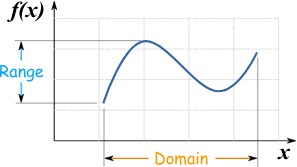3.1: Graphing Relationships
Vocabulary:
Continuous graph- represent real-world situations that are drawn without any interruptions made up of connected lines or curves.
Discrete graphs: are made up of distinct, unconnected points.
Continuous vs. Discrete with Examples
 Video Explanation: Graphing Relationships and Interpreting Graphs
Video Explanation: Graphing Relationships and Interpreting Graphs
3.2: Understanding Relations and Functions
Vocabulary
Relation: a set of ordered pairs (x, y) where x is the input value and y is the output value.
Function: type of relationship in which there is only one output value for each input value
Vertical line test: a relation is a function if a vertical line does not pass through more than one point on the graph of the relation
Domain: Represents all inputs
Range: Represents all outputs
Range depends on Domain
Y depends on x
3.3: Modeling Functions
Vocabulary
Independent Variable: The input of a function (Domain)
Dependent variable: The output of a function (Range)
Function notation: If x is the independent variable and y is the dependent variable, then you can use function notation to write y = ƒ(x), which is read “y equals ƒunction of x,” where ƒ names the function
Function Rule: An algebraic expression that defines a function
3.4: Graphing Functions
There are a few different ways to write the equation of a line. One of the most common ways is called the "slope-intercept" form. It's called this because it clearly identifies theslope and the y-intercept in the equation. The slope is the number written before the x. The y-intercept is the constant written at the end.
How To Graph a Line in Slope-Intercept Form
 Note
Note Studied by 12 people
Studied by 12 people Note
Note Studied by 34 people
Studied by 34 people Note
Note Studied by 8631 people
Studied by 8631 people Note
Note Studied by 14 people
Studied by 14 people Note
Note Studied by 9 people
Studied by 9 people Note
Note Studied by 9 people
Studied by 9 people Knowt
Knowt

 Video Explanation:
Video Explanation: